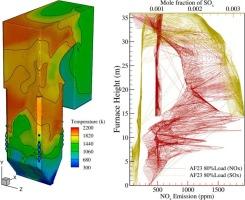亚临界燃煤炉不同负荷影响下NOx、SOx排放和燃烧动力学的CFD建模
IF 7.5
1区 工程技术
Q2 ENERGY & FUELS
引用次数: 0
摘要
本研究考察了125兆瓦巴拉普库里亚热电厂(BTPP)燃烧烟煤(C137H97O9NS)的排放和燃烧行为。建立了考虑扩展Zeldovich机制NOx方案和不同负荷(50% ~ 100%燃料负荷)下SOx排放的三维计算流体动力学(CFD)模型。采用ddm离散液滴法、dtrm离散传递辐射模型和标准k -ε湍流模型对流动动力学、颗粒弥散、热速率和燃速进行了研究。研究了燃烧器喉道的最高温度在1850 ~ 2200k之间,以及不同负荷水平下热态、瞬态和燃料态NOx的排放曲线。氮氧化物的总量从满载时的381ppm增加到50%负荷时的974ppm。由于硫输入量减少,燃烧温度和停留时间(τ)降低,限制了硫化合物的氧化,SO2摩尔分数的数量从0.000387下降到0.000206。在较低负荷条件下,由于气体停留时间(τ)较长且部分未燃烧,NO、NO2和N2O含量最高。研究表明,该反应具有更快的脱挥发速率和更长的停留焦燃速率。随着负载的增加,挥发速率范围为0.0001 ~ 0.00042 mol.m−3。在0.00025 ~ 0.00065 mol.m−3.s−1范围内,焦炭烧烬强度逐渐增大。本文章由计算机程序翻译,如有差异,请以英文原文为准。

CFD modeling of varying load-influenced NOx, SOx emissions and combustion kinetics in a sub-critical coal-fired furnace
This study investigates emissions and combustion behavior of the 125 MWe Barapukuria Thermal Power Plant (BTPP) by burning Bituminous coal (C137H97O9NS). A 3D computational fluid dynamics (CFD) model is developed considering NOx scheme through Extended Zeldovich mechanism and SOx emission under various loads (50 % to 100 % fuel load). The study uses DDM-Discrete Droplet Method, DTRM-Discrete Transfer Radiation Model, and a standard k–ε turbulence model to study flow dynamics, particle dispersion, heat rate and burnout rate. It is studied that the highest temperatures in the burner throat range from 1850 K to 2200 K with emission profiles of thermal, prompt, and fuel NOx at different load levels. The total amount of NOx goes from 381 ppm at full load to 974 ppm at 50 % load at final exit. The amount of SO2 mole fractions goes down 0.000387 to 0.000206 for reduced sulfur input and lower combustion temperatures, residence time (τ) which limit the oxidation of sulfur compounds. The lower load conditions have the highest levels of NO, NO2, N2O because the gases stay longer residence time (τ) and remain unburn partially. The study shows the reaction kinetics of faster devolatilization and longer residence char burnout rates. As load rises the volatilization rate ranges from 0.0001 to 0.00042 mol.m−3.s−1 and the intense char burnout intensifies from 0.00025 to 0.00065 mol.m−3.s−1.
求助全文
通过发布文献求助,成功后即可免费获取论文全文。
去求助
来源期刊

Fuel
工程技术-工程:化工
CiteScore
12.80
自引率
20.30%
发文量
3506
审稿时长
64 days
期刊介绍:
The exploration of energy sources remains a critical matter of study. For the past nine decades, fuel has consistently held the forefront in primary research efforts within the field of energy science. This area of investigation encompasses a wide range of subjects, with a particular emphasis on emerging concerns like environmental factors and pollution.
 求助内容:
求助内容: 应助结果提醒方式:
应助结果提醒方式:


